Reproductive Abnormalities
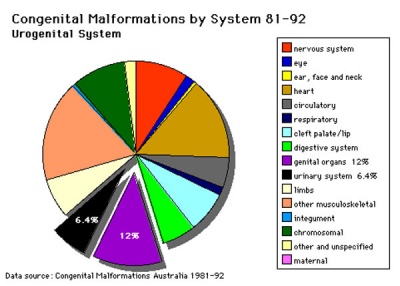
|
This page introduces the statistical data associated with birth abnormalities in the genital system in Australia and also briefly introduces some of these defects. For more detailed coverage look at the Genital Abnormalities Notes. Abnormalites associated with development of secondary sex characteristics including mammary development are not covered in this current practical class.
Note that some abnormalites affect physiological function, while others through mainly perturbed endocrine effects, can impact upon not only other systems but also have neurological ramifications upon sexual identity. Then finally look at the online information provided to the general public on birth defects associated with genital system development and sexuality.
Genital abnormalities fall into several categories: chromosomal, intersex, gonadal dysfunction, tract abnormalities, external genitalia and gonadal descent.
|
- Links: Genital System - Abnormalities
Critical Periods
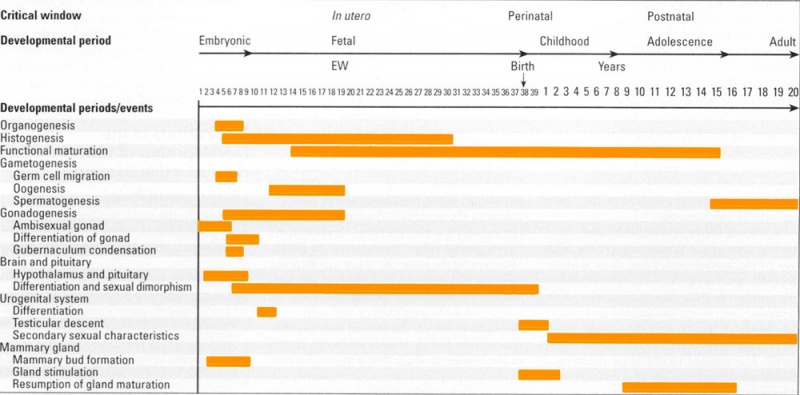
Gonadal Descent
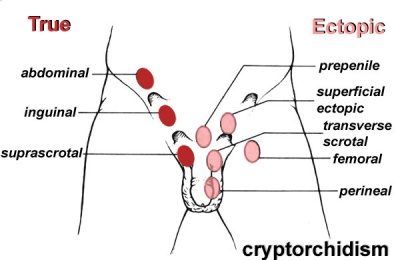
|
Cryptorchidism
- an abnormality of either unilateral or bilateral testicular descent
- occurring in up to 30% premature and 3-4% term males
- Descent may complete postnatally in the first year, failure to descend can result in sterility.
|
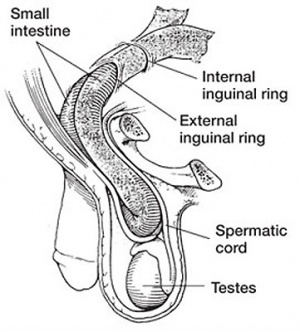
|
Hernia
- Indirect inguinal hernia is a common condition in male infants
- resulting from a patent processus vaginalis
- allowing communication between the peritoneal cavity and the scrotal sac
- through which portions or loops of small intestine may herniate.
- This is a common surgical repair operation in young children.
Hydrocele
- a fluid-filled cavity of eiter testis or spermatic cord, where peritoneal fluid passes into a patent processus vaginalis.
- Hydrocele of the testis is when a very small patent processus vaginalis may not herniate, but allow fluid to pass from the periotoneal cavity leading to the collection of serous fluid between the layers of the membrane (tunica vaginalis).
- Normal - fluid around the testicle is absorbed
- Noncommunicating hydrocele - fluid remains around the testicle
- Communicating hydrocele - fluid flows back and forth between the scrotum and the abdomen
- Hydrocele of the cord - fluid is located between the scrotum and the abdomen
|
External Genitalia
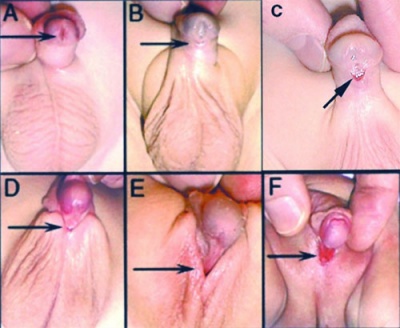
|
Hypospadia
- most common penis abnormality (1 in 300)
- a failure of male urogenital folds to fuse in various regions
- resulting in a proximally displaced urethral meatus.
- cause is unknown, but suggested to involve many factors either indivdually or in combination including: familial inheritance, low birth weight, assisted reproductive technology, advanced maternal age, paternal subfertility and endocrine-disrupting chemicals. Infants with hypospadias should not undergo circumcision.
Opening of the urethra (meatus) on the inferior surface (ring) not at the tip. Other regions where urethra may open to the surface (dashed line).
|
- Links: Genital System - Abnormalities
Internal Genitalia
Male
- Ductus Deferens - unilateral or bilateral absence congenital unilateral absence of the vas deferens (CUAVD), Congenital bilateral absence of the vas deferens (CBAVD)
failure of mesonephric duct to differentiate
frequent cause of obstructive azoospermia
75% of men with bilateral absence have at least one detectable common mutation in the cystic fibrosis transmembrane conductance regulator (CFTR) gene
Female
Uterine Duplication, Unicornate Uterus, Septate Uterus.

This cartoon shows the new 2013 ESHRE-ESGE classification system [1] based on uterine anatomy, embryological origin is the secondary basic characteristic, and both cervical and vaginal anomalies are classified in independent co-existent sub-classes. For more detail see Additional Information.
| This ultrasound scan shows a bicornuate uterus and an ectopic (cornual) pregnancy.
|
|
- Cervical - cervical agenesis, cervical duplication
- Vagina Absence - Failure of sinovaginal bulb development, 1 in 4,000 to 5,000 female births.
Other Abnormalities
Use the links to find out more about these topics.
- Congenital Adrenal Hyperplasia - impairment of cortisol production by the adrenal cortex, is one of the most common causes of intersex genitalia at birth.
- Androgen Insensitivity Syndrome - genetically male (XY) unable to respond to male sex hormones (androgens), they may have mostly female sex characteristics or signs of both male and female sexual development. Also a partial androgen insensitivity syndrome (PAIS) associated with impaired male genital development that can be transmitted through mutations in the androgen receptor.
- Cryptorchidism - covered in detail above.
- Undescended Ovaries - reasonably rare gonad abnormality, often detected following clinical assessment of fertility problems and may also be associated with other uterine malformations (unicornuate uterus).
- Hydrocele - covered above, most commonly male (but can also be female) fluid-filled cavity.
Additional Information
| Additional Information - Content shown under this heading is not part of the material covered in this class. It is provided for those students who would like to know about some concepts or current research in topics related to the current class page.
|
International Classification of Diseases - XVII Congenital Malformations
| ICD10 Congenital malformations of genital organs (Q50-Q56)
|
| The International Classification of Diseases (ICD) World Health Organization's classification used worldwide as the standard diagnostic tool for epidemiology, health management and clinical purposes. Includes this section on XVII Congenital Malformations.
|
| Congenital malformations of genital organs (Q50-Q56)
Excl.: androgen resistance syndrome (E34.5) syndromes associated with anomalies in the number and form of chromosomes (90-99) testicular feminization syndrome (E34.5)
|
Q50 Congenital malformations of ovaries, fallopian tubes and broad ligaments
- Q50.0 Congenital absence of ovary Excl.: Turner's syndrome (96.-)
- Q50.1 Developmental ovarian cyst
- Q50.2 Congenital torsion of ovary
- Q50.3 Other congenital malformations of ovary Accessory ovary Congenital malformation of ovary NOS Ovarian streak
- Q50.4 Embryonic cyst of fallopian tube Fimbrial cyst
- Q50.5 Embryonic cyst of broad ligament Cyst: epoophoron Gartner's duct parovarian
- Q50.6 Other congenital malformations of fallopian tube and broad ligament Absence Accessory Atresia (of) fallopian tube or broad ligament Congenital malformation of fallopian tube or broad ligament NOS
|
Q51 Congenital malformations of uterus and cervix
- Q51.0 Agenesis and aplasia of uterus Congenital absence of uterus
- Q51.1 Doubling of uterus with doubling of cervix and vagina
- Q51.2 Other doubling of uterus Doubling of uterus NOS
- Q51.3 Bicornate uterus
- Q51.4 Unicornate uterus
- Q51.5 Agenesis and aplasia of cervix Congenital absence of cervix
- Q51.6 Embryonic cyst of cervix
- Q51.7 Congenital fistulae between uterus and digestive and urinary tracts
- Q51.8 Other congenital malformations of uterus and cervix Hypoplasia of uterus and cervix
- Q51.9 Congenital malformation of uterus and cervix, unspecified
|
Q52 Other congenital malformations of female genitalia
- Q52.0 Congenital absence of vagina
- Q52.1 Doubling of vagina Septate vagina Excl.: doubling of vagina with doubling of uterus and cervix (51.1)
- Q52.2 Congenital rectovaginal fistula Excl.: cloaca (43.7)
- Q52.3 Imperforate hymen
- Q52.4 Other congenital malformations of vagina Congenital malformation of vagina NOS Cyst: canal of Nuck, congenital embryonic vaginal
- Q52.5 Fusion of labia
- Q52.6 Congenital malformation of clitoris
- Q52.7 Other congenital malformations of vulva Congenital: absence cyst malformation NOS of vulva
- Q52.8 Other specified congenital malformations of female genitalia
- Q52.9 Congenital malformation of female genitalia, unspecified
|
Q53 Undescended testicle
- Q53.0 Ectopic testis Unilateral or bilateral ectopic testes
- Q53.1 Undescended testicle, unilateral
- Q53.2 Undescended testicle, bilateral
- Q53.9 Undescended testicle, unspecified Cryptorchism NOS
|
| Q54 Hypospadias
Excl.: epispadias (64.0)
- Q54.0 Hypospadias, balanic Hypospadias: coronal glandular
- Q54.1 Hypospadias, penile
- Q54.2 Hypospadias, penoscrotal
- Q54.3 Hypospadias, perineal
- Q54.4 Congenital chordee
- Q54.8 Other hypospadias
- Q54.9 Hypospadias, unspecified
|
| Q55 Other congenital malformations of male genital organs
Excl.: congenital hydrocele (P83.5) hypospadias (54.-)
- Q55.0 Absence and aplasia of testis Monorchism
- Q55.1 Hypoplasia of testis and scrotum Fusion of testes
- Q55.2 Other congenital malformations of testis and scrotum Congenital malformation of testis or scrotum NOS Polyorchism Retractile testis Testis migrans
- Q55.3 Atresia of vas deferens
- Q55.4 Other congenital malformations of vas deferens, epididymis, seminal vesicles and prostate Absence or aplasia of: prostate spermatic cord Congenital malformation of vas deferens, epididymis, seminal vesicles or prostate NOS
- Q55.5 Congenital absence and aplasia of penis
- Q55.6 Other congenital malformations of penis Congenital malformation of penis NOS Curvature of penis (lateral) Hypoplasia of penis
- Q55.8 Other specified congenital malformations of male genital organs
- Q55.9 Congenital malformation of male genital organ, unspecified Congenital: anomaly deformity NOS of male genital organ
|
| Q56 Indeterminate sex and pseudohermaphroditism
Excl.: pseudohermaphroditism: female, with adrenocortical disorder (E25.-) male, with androgen resistance (E34.5) with specified chromosomal anomaly (96-99)
- Q56.0 Hermaphroditism, not elsewhere classified Ovotestis
- Q56.1 Male pseudohermaphroditism, not elsewhere classified Male pseudohermaphroditism NOS
- Q56.2 Female pseudohermaphroditism, not elsewhere classified Female pseudohermaphroditism NOS
- Q56.3 Pseudohermaphroditism, unspecified
- Q56.4 Indeterminate sex, unspecified Ambiguous genitalia
|
| Please note that this category uses old terminology, that has been replaced elsewhere with "Disorders of Sex Development (DSD)".
|
| World Health Organisation. International Statistical Classification of Diseases and Related Health Problems. (1992) 10th Revision (ICD-10). Geneva: WHO ICD-10 - 2016 Online (English)
|
|
|
| ICD10 - Gastrointestinal | Genital | Renal | Integumentary
|
| ICD10 Congenital malformations of the urinary system (Q60-Q64)
|
| The International Classification of Diseases (ICD) World Health Organization's classification used worldwide as the standard diagnostic tool for epidemiology, health management and clinical purposes. Includes this section on XVII Congenital Malformations.
|
| Q60 Renal agenesis and other reduction defects of kidney
Incl.: atrophy of kidney: congenital infantile congenital absence of kidney
- Q60.0 Renal agenesis, unilateral
- Q60.1 Renal agenesis, bilateral
- Q60.2 Renal agenesis, unspecified
- Q60.3 Renal hypoplasia, unilateral
- Q60.4 Renal hypoplasia, bilateral
- Q60.5 Renal hypoplasia, unspecified
- Q60.6 Potter's syndrome
|
| Q61 Cystic kidney disease
Excl.: acquired cyst of kidney (N28.1) Potter's syndrome (60.6)
- Q61.0 Congenital single renal cyst Cyst of kidney (congenital)(single)
- Q61.1 Polycystic kidney, autosomal recessive Polycystic kidney, infantile type
- Q61.2 Polycystic kidney, autosomal dominant Polycystic kidney, adult type
- Q61.3 Polycystic kidney, unspecified
- Q61.4 Renal dysplasia Multicystic: dyplastic kidney kidney (developmental) kidney disease renal dysplasia Excl.: polycystic kidney disease (61.1-61.3)
- Q61.5 Medullary cystic kidney Sponge kidney NOS
- Q61.8 Other cystic kidney diseases Fibrocystic: kidney renal degeneration or disease
- Q61.9 Cystic kidney disease, unspecified Meckel-Gruber syndrome
|
Q62 Congenital obstructive defects of renal pelvis and congenital malformations of ureter
- Q62.0 Congenital hydronephrosis
- Q62.1 Atresia and stenosis of ureter Congenital occlusion of: ureter ureteropelvic junction ureterovesical orifice Impervious ureter
- Q62.2 Congenital megaloureter Congenital dilatation of ureter
- Q62.3 Other obstructive defects of renal pelvis and ureter Congenital ureterocele
- Q62.4 Agenesis of ureter Absent ureter
- Q62.5 Duplication of ureter Accessory Double ureter
- Q62.6 Malposition of ureter Deviation Displacement Ectopic Implantation, anomalous (of) ureter or ureteric orifice
- Q62.7 Congenital vesico-uretero-renal reflux
- Q62.8 Other congenital malformations of ureter Anomaly of ureter NOS
|
| Q63 Other congenital malformations of kidney
Excl.: congenital nephrotic syndrome (N04.-)
- Q63.0 Accessory kidney
- Q63.1 Lobulated, fused and horseshoe kidney
- Q63.2 Ectopic kidney Congenital displaced kidney Malrotation of kidney
- Q63.3 Hyperplastic and giant kidney
- Q63.8 Other specified congenital malformations of kidney Congenital renal calculi
- Q63.9 Congenital malformation of kidney, unspecified
|
Q64 Other congenital malformations of urinary system
- Q64.0 Epispadias Excl.: hypospadias (54.-)
- Q64.1 Exstrophy of urinary bladder Ectopia vesicae Extroversion of bladder
- Q64.2 Congenital posterior urethral valves
- Q64.3 Other atresia and stenosis of urethra and bladder neck Congenital: bladder neck obstruction stricture of: urethra urinary meatus vesicourethral orifice Impervious urethra
- Q64.4 Malformation of urachus Cyst of urachus Patent urachus Prolapse of urachus
- Q64.5 Congenital absence of bladder and urethra
- Q64.6 Congenital diverticulum of bladder
- Q64.7 Other congenital malformations of bladder and urethra Accessory: bladder urethra Congenital: hernia of bladder malformation of bladder or urethra NOS prolapse of: bladder (mucosa) urethra urinary meatus urethrorectal fistula Double: urethra urinary meatus
- Q64.8 Other specified congenital malformations of urinary system
- Q64.9 Congenital malformation of urinary system, unspecified Congenital: anomaly deformity NOS of urinary system
|
| World Health Organisation. International Statistical Classification of Diseases and Related Health Problems. (1992) 10th Revision (ICD-10). Geneva: WHO ICD-10 - 2016 Online (English)
|
|
|
| ICD10 - Gastrointestinal | Genital | Renal | Integumentary
|
Disorders of Sex Development
The previous human sex development terminology (true hermaphrodites, male pseudohermaphrodites and female pseudohermaphrodites) are considered outdated and stigmatising and have been replaced with the general term Disorders of Sex Development (DSD) established by the Consensus statement on management of intersex disorders.[2] See also the Medical Journal of Australia 2009 editorial article.[3]
| Previous Terminology
|
New Proposed Terminology
|
| Intersex
|
DSD
|
| Male pseudohermaphrodite, undervirilization of an XY male, and undermasculinization of an XY male
|
46,XY DSD
|
| Female pseudohermaphrodite, overvirilization of an XX female, and masculinization of an XX female
|
46,XX DSD
|
| True hermaphrodite
|
Ovotesticular DSD
|
| XX male or XX sex reversal
|
46,XX testicular DSD
|
| XY sex reversal
|
46,XY complete gonadal dysgenesis
|
Hypospadia
| Hypospadia Classification
|
Meatus Opening
|
| Anterior
|
on inferior surface of glans penis
|
| Coronal
|
in balanopenile furrow
|
| Distal
|
on distal third of shaft
|
| Penoscrotal
|
at base of shaft in front of scrotum
|
| Scrotal
|
on scrotum or between the genital swellings
|
| Perineal
|
behind scrotum or genital swellings
|
- Epispadias - Uncommon abnormality associated with the penis, 1 in 30,000 infant males, external urethral opening on the dorsal surface of penis.
- Cryptorchidism in common eutherian mammals.[4]- Species comparison of descent timeline
- Mayer-Rokitansky syndrome (MRK anomaly, Rokitansky-Küster-Hauser syndrome, RKH syndrome, RKH) congenital absence of the vagina, dyspareunia, vaginal agenesis.
Uterine Anomalies
| ESHRE/ESGE Classification of Uterine Anomalies
|
European Society of Human Reproduction and Embryology (ESHRE) and the European Society for Gynaecological Endoscopy (ESGE)
- Class U0 - incorporates all cases with normal uterus.
- Class U1 - (Dysmorphic uterus) incorporates all cases with normal uterine outline but with an abnormal shape of the uterine cavity excluding septa. Class I is further subdivided into three categories
- Class U1a - (T-shaped uterus) characterized by a narrow uterine cavity due to thickened lateral walls with a correlation 2/3 uterine corpus and 1/3 cervix,
- Class U1b - (uterus infantilis) characterized also by a narrow uterine cavity without lateral wall thickening and an inverse correlation of 1/3 uterine body and 2/3 cervix
- Class U1c - (others) which is added to include all minor deformities of the uterine cavity including those with an inner indentation at the fundal midline level of less than 50 % of the uterine wall thickness.
- Class U2 - (septate uterus) internal indentation >50 % of the uterine wall thickness & external contour straight or with indentation <50 %
- Class U2a - (partial septate uterus) characterized by the existence of a septum dividing partly the uterine cavity above the level of the internal cervical os
- Class U2b - (complete septate uterus) characterized by the existence of a septum fully dividing the uterine cavity up to the level of the internal cervical os.
- Class U3 - (bicorporeal uterus) external indentation >50 % of the uterine wall thickness
- Class U3a - (partial bicorporeal uterus) characterized by an external fundal indentation partly dividing the uterine corpus above the level of the cervix
- Class U3b - (complete bicorporeal uterus) width of the fundal indentation at the midline >150 % of the uterine wall thickness) completely dividing the uterine corpus up to the level of the cervix
- Class U3c - (bicorporeal septate uterus) characterized by the presence of an absorption defect in addition to the main fusion defect.
- Class U4 - (hemi-uterus) incorporates all cases of unilateral formed uterus. Hemi-uterus is defined as the unilateral uterine development; the contralateral part could be either incompletely formed or absent.
- Class U4a - (hemi-uterus with a rudimentary (functional) cavity) characterized by the presence of a communicating or non-communicating functional contralateral horn
- Class U4b - (hemi-uterus without rudimentary (functional) cavity) characterized either by the presence of non-functional contralateral uterine horn or by aplasia of the contralateral part.
- Class U5 - (aplastic uterus) incorporates all cases of uterine aplasia, formation defect characterized by the absence of any fully or unilaterally developed uterine cavity.
- Class U5a - (aplastic uterus with rudimentary (functional) cavity) characterized by the presence of bi- or unilateral functional horn
- Class U5b - (aplastic uterus without rudimentary (functional) cavity) characterized either by the presence of uterine remnants or by full uterine aplasia.
- Class U6 - is kept for still unclassified cases.
|

|
| <pubmed>23894234</pubmed>
See also ICD10 Congenital malformations of genital organs (Q50-Q56)
- Links: Genital System - Abnormalities | Uterus Development | image - simplified cartoon
|
- Uterine Duplication (uterus didelphys, double uterus, uterus didelphis) A rare uterine developmental abnormality where the paramesonephric ducts (Mullerian ducts) completely fail to fuse generating two separate uterus parts each connected to the cervix and having an ovary each. Failure of fusion of lower paramesonephric ducts, with either double or single vagina.
- Unicornate Uterus - failure of the paramesonephric ducts to fuse. A single paramesomnephric duct has fused with the vaginal plate and now opens into the vagina, while the other forms a diverticulum.
- Septate Uterus
Polycystic Ovary Syndrome
(PCOS) or Stein–Leventhal syndrome (1930s researchers) a metabolic syndrome with many other symptoms, ovarian cysts arise through incomplete follicular development or failure of ovulation. For review see [5]
Environmental Abnormalities
- Diethylstilbestrol (DES or diethylstilbetrol) - is a drug that was prescribed to women from 1938-1971 to prevent miscarriage in high-risk pregnancies.
- The drug acted as a potent estrogen (mimics natural hormone) and therefore could also act as a potential endocrine disruptor.
- This led to a number of developing fetal reproductive tract and other abnormalities.
- In the female fetus, it increased risk of abnormal reproductive tract and also carcinogenic (cancer forming).
- In the male fetus, it increased the occurance of abnormal genitalia.
- The drug was banned by FDA (USA) in 1979 as a teratogen, it had previously also been used as livestock growth promoter and could have potentially entered the human food chain.
References
BGDB: Lecture - Gastrointestinal System | Practical - Gastrointestinal System | Lecture - Face and Ear | Practical - Face and Ear | Lecture - Endocrine | Lecture - Sexual Differentiation | Practical - Sexual Differentiation | Tutorial
Glossary Links
- Glossary: A | B | C | D | E | F | G | H | I | J | K | L | M | N | O | P | Q | R | S | T | U | V | W | X | Y | Z | Numbers | Symbols | Term Link
Cite this page: Hill, M.A. (2024, April 19) Embryology BGDB Sexual Differentiation - Abnormalities. Retrieved from https://embryology.med.unsw.edu.au/embryology/index.php/BGDB_Sexual_Differentiation_-_Abnormalities
- What Links Here?
- © Dr Mark Hill 2024, UNSW Embryology ISBN: 978 0 7334 2609 4 - UNSW CRICOS Provider Code No. 00098G






